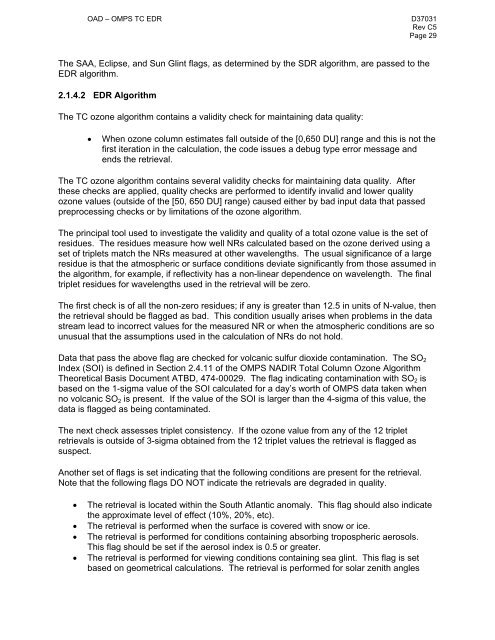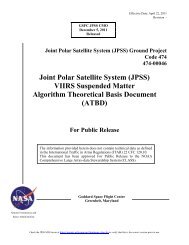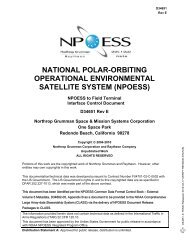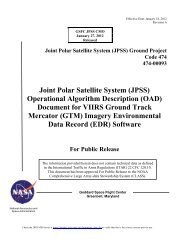(OAD) Document for Ozone Mapping and Profiler Suite ... - NASA
(OAD) Document for Ozone Mapping and Profiler Suite ... - NASA
(OAD) Document for Ozone Mapping and Profiler Suite ... - NASA
Create successful ePaper yourself
Turn your PDF publications into a flip-book with our unique Google optimized e-Paper software.
<strong>OAD</strong> – OMPS TC EDR D37031<br />
Rev C5<br />
Page 29<br />
The SAA, Eclipse, <strong>and</strong> Sun Glint flags, as determined by the SDR algorithm, are passed to the<br />
EDR algorithm.<br />
2.1.4.2 EDR Algorithm<br />
The TC ozone algorithm contains a validity check <strong>for</strong> maintaining data quality:<br />
� When ozone column estimates fall outside of the [0,650 DU] range <strong>and</strong> this is not the<br />
first iteration in the calculation, the code issues a debug type error message <strong>and</strong><br />
ends the retrieval.<br />
The TC ozone algorithm contains several validity checks <strong>for</strong> maintaining data quality. After<br />
these checks are applied, quality checks are per<strong>for</strong>med to identify invalid <strong>and</strong> lower quality<br />
ozone values (outside of the [50, 650 DU] range) caused either by bad input data that passed<br />
preprocessing checks or by limitations of the ozone algorithm.<br />
The principal tool used to investigate the validity <strong>and</strong> quality of a total ozone value is the set of<br />
residues. The residues measure how well NRs calculated based on the ozone derived using a<br />
set of triplets match the NRs measured at other wavelengths. The usual significance of a large<br />
residue is that the atmospheric or surface conditions deviate significantly from those assumed in<br />
the algorithm, <strong>for</strong> example, if reflectivity has a non-linear dependence on wavelength. The final<br />
triplet residues <strong>for</strong> wavelengths used in the retrieval will be zero.<br />
The first check is of all the non-zero residues; if any is greater than 12.5 in units of N-value, then<br />
the retrieval should be flagged as bad. This condition usually arises when problems in the data<br />
stream lead to incorrect values <strong>for</strong> the measured NR or when the atmospheric conditions are so<br />
unusual that the assumptions used in the calculation of NRs do not hold.<br />
Data that pass the above flag are checked <strong>for</strong> volcanic sulfur dioxide contamination. The SO2<br />
Index (SOI) is defined in Section 2.4.11 of the OMPS NADIR Total Column <strong>Ozone</strong> Algorithm<br />
Theoretical Basis <strong>Document</strong> ATBD, 474-00029. The flag indicating contamination with SO2 is<br />
based on the 1-sigma value of the SOI calculated <strong>for</strong> a day’s worth of OMPS data taken when<br />
no volcanic SO2 is present. If the value of the SOI is larger than the 4-sigma of this value, the<br />
data is flagged as being contaminated.<br />
The next check assesses triplet consistency. If the ozone value from any of the 12 triplet<br />
retrievals is outside of 3-sigma obtained from the 12 triplet values the retrieval is flagged as<br />
suspect.<br />
Another set of flags is set indicating that the following conditions are present <strong>for</strong> the retrieval.<br />
Note that the following flags DO NOT indicate the retrievals are degraded in quality.<br />
� The retrieval is located within the South Atlantic anomaly. This flag should also indicate<br />
the approximate level of effect (10%, 20%, etc).<br />
� The retrieval is per<strong>for</strong>med when the surface is covered with snow or ice.<br />
� The retrieval is per<strong>for</strong>med <strong>for</strong> conditions containing absorbing tropospheric aerosols.<br />
This flag should be set if the aerosol index is 0.5 or greater.<br />
� The retrieval is per<strong>for</strong>med <strong>for</strong> viewing conditions containing sea glint. This flag is set<br />
based on geometrical calculations. The retrieval is per<strong>for</strong>med <strong>for</strong> solar zenith angles






